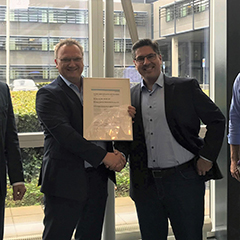- 8 MW Direct Drive machine with 167-meter diameter rotor is fully compliant to the new IEC’s Renewable Energy scheme for type certification of wind turbines
- Turbine will be installed in offshore wind parks worldwide including the Hornsea 2 project in UK and Greater Changhua 1 & 2a project in Taiwan.
Hamburg, Germany, 3rd October 2019 – DNV GL has awarded Siemens Gamesa Renewable Energy with the Type Certificate for offshore for its SG 8.0-167 DD offshore wind turbine. The certificate confirms full compliance of the turbine design to the international wind turbine standard IECRE OD-501 and allows for immediate market implementation. The turbine will be installed in offshore wind parks worldwide including the 1,400 MW Hornsea 2 project in the UK and the 900 MW Greater Changhua 1 & 2a project in Taiwan.
Compared to its predecessor, the SG 8.0-167 DD is equipped with an 81-meter-long rotor blade that allows for a wider range and optimal usage of the wind site conditions. Large capacity offshore wind turbines contribute greatly to the ongoing reduction of the Levelized Cost of Energy from wind power. Siemens Gamesa’s SG 8.0-167 DD turbine provides an increase in annual energy production of 20% compared to the previously certified turbine variant, the SWT-7.0-154.
“In our recently published Energy Transition Outlook Report, we predict a significant growth of installed capacity for offshore-wind powered generation from 20 GW in 2017 to 150 GW in 2030 and even 1,550 GW in 2050,” said Kim Mørk, Executive Vice President of Renewables Certification at DNV GL. ”To realise this ambitious growth of wind energy, it is vital that OEMs like Siemens Gamesa continue to optimise turbine types that deliver significantly improved energy production and cost efficiency, driven in part by increased turbine, blade, and tower size. These trends result in improved energy capture per project or lower cost per MWh,” he continued.
“We are pleased to receive the full Type Certificate for offshore from DNV GL for our SG 8.0-167 DD offshore wind turbine. This verification demonstrates Siemens Gamesa’s commitment to maintaining the highest quality and performance standards for our offshore wind turbines. Shortening the time-to-market enables us to more swiftly deliver our products to our customers, and continue our contribution to combatting climate change,”, says Morten Pilgaard Rasmussen, Siemens Gamesa’s Offshore Head of Technology.”
Siemens Gamesa’s SG 8.0-167 DD turbine is suitable for both 50 Hertz and 60 Hertz grid operation.
About DNV GL
DNV GL is a global quality assurance and risk management company. Driven by our purpose of safeguarding life, property and the environment, we enable our customers to advance the safety and sustainability of their business. We provide classification, technical assurance, software and independent expert advisory services to the maritime, oil & gas, power and renewables industries. We also provide certification, supply chain and data management services to customers across a wide range of industries. Operating in more than 100 countries, our experts are dedicated to helping customers make the world safer, smarter and greener.
DNV GL delivers world-renowned testing, certification and advisory services to the energy value chain including renewables and energy management. Our expertise spans onshore and offshore wind power, solar, conventional generation, transmission and distribution, smart grids, and sustainable energy use, as well as energy markets and regulations. Our experts support customers around the globe in delivering a safe, reliable, efficient, and sustainable energy supply.
Learn more at www.dnvgl.com/power-renewables
About Siemens Gamesa Offshore
As of June 2019, SGRE has over 3,300 offshore wind turbines in operation globally with a combined capacity of more than 14 GW. The company’s experiences reach back as far as 1991, when it established the world’s first offshore wind power plant. Through a strong focus on safety and innovation, SGRE constantly strives to reduce the Levelized Cost of Energy from offshore wind power.


























